货币银行学第13章纸质练习(附答案) - 副本
《货币银行学》考试题(带答案)
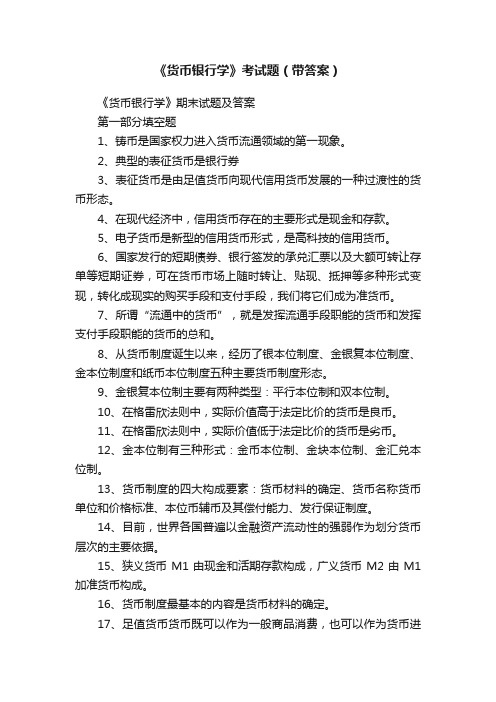
《货币银行学》考试题(带答案)《货币银行学》期末试题及答案第一部分填空题1、铸币是国家权力进入货币流通领域的第一现象。
2、典型的表征货币是银行券3、表征货币是由足值货币向现代信用货币发展的一种过渡性的货币形态。
4、在现代经济中,信用货币存在的主要形式是现金和存款。
5、电子货币是新型的信用货币形式,是高科技的信用货币。
6、国家发行的短期债券、银行签发的承兑汇票以及大额可转让存单等短期证券,可在货币市场上随时转让、贴现、抵押等多种形式变现,转化成现实的购买手段和支付手段,我们将它们成为准货币。
7、所谓“流通中的货币”,就是发挥流通手段职能的货币和发挥支付手段职能的货币的总和。
8、从货币制度诞生以来,经历了银本位制度、金银复本位制度、金本位制度和纸币本位制度五种主要货币制度形态。
9、金银复本位制主要有两种类型:平行本位制和双本位制。
10、在格雷欣法则中,实际价值高于法定比价的货币是良币。
11、在格雷欣法则中,实际价值低于法定比价的货币是劣币。
12、金本位制有三种形式:金币本位制、金块本位制、金汇兑本位制。
13、货币制度的四大构成要素:货币材料的确定、货币名称货币单位和价格标准、本位币辅币及其偿付能力、发行保证制度。
14、目前,世界各国普遍以金融资产流动性的强弱作为划分货币层次的主要依据。
15、狭义货币M1由现金和活期存款构成,广义货币M2由M1加准货币构成。
16、货币制度最基本的内容是货币材料的确定。
17、足值货币货币既可以作为一般商品消费,也可以作为货币进行流通。
18、一个国家的基本通货和法定的计价结算货币称为本位币亦称主币。
19、在纸币制度下,如果在同一市场上出现两种以上纸币流通时,会出现货币的良币驱逐劣币。
20、现代经济中信用货币的发行主体是银行。
第二部分单项选择题1、纸币的发行是建立在货币 B 职能基础上的。
A、价值尺度B、流通手段C、支付手段D、储藏手段2、历史上最早出现的货币形态是 A 。
《货币银行学》第1-15章答案

第一章答案四、思考题A、B、C详解1.1 答案详解:A金银作为自然的产物,其只有在人类社会出现之后才作为货币,因此金银天然不是货币,B选项错误。
货币的本质是一般等价物,贝壳、铜在历史上都曾经做过货币,因此C选项错误。
金银只有在作为货币使用时才能作为一般等价物。
D选项也错误。
综合,A说法正确。
1.2 答案详解:A纸币是由国家发行的、强制使用的货币符号。
纸币的发行数量、面值等等都是由国家决定的,体现着一个国家的货币政策。
但是,货币的购买力不是由国家或者法律决定的,而是由货币发行数量和经济发展状况决定的。
如果生产力水平不变,社会生产出的总的商品数量不变,而流通中的货币数量为原来的两倍,那么商品的价格也会变成原来的两倍,此时每种面值的货币只代表原来一半的价值。
因此选A。
1.3 答案详解:ACDF在商品交换过程中,价值形式的发展经历的四个阶段有简单的价值形式、扩大的价值形式、相对价值形式、一般价值形式。
参见第一章第一节有关内容1.4 答案详解:银行券指由银行发行的以信用作为保证的可以兑现的银行票据,是以银行信用为担保所产生的一种信用工具银行券有其自身的发展历程。
开始时为安全的缘故,一些人将金银交由从事货币兑换业务的商铺保存,商铺则给客户开出相应收据,并承诺随时提取原有数量的金银;后来,由于交易和支付日益频繁,人们可以使用保管凭条进行直接收付,这就是银行券的雏形。
随着商业信用的不断扩大和发展,商业票据的运用范围日益广泛,但持票人只能到期才能兑现自己所持有的商业票据。
为了解决持票人临时需要资金的问题,银行进行金融创新,开展贴现业务,并且当银行的现款不足以支付持票人时,银行可以使用自己发行的银行券来支付。
1.5 答案详解:当货币在生活中日益重要时,一般说来,作为货币的商品有如下四个基本特征:一是价值比较高,这样可用较少的媒介完成较大量的商品交换;二是易于分割,一方面分割之后不会减少它的价值,另一方面分割成本较低,以便于同价值高低不等的商品交换;三是易于保存,即在保存过程中不会损失价值,费用很低;四是便于携带,以利于扩大化的商品交易。
第13章通货膨胀与通货紧缩《货币银行学》
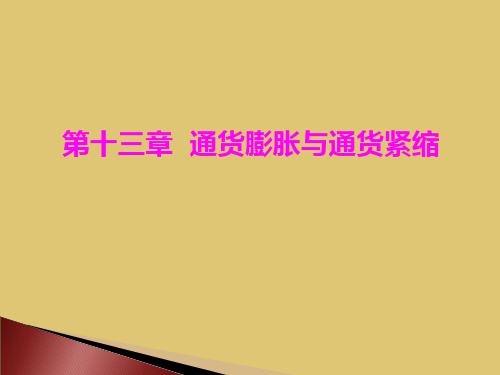
第一节 通货膨胀的定义、度量 和分类
三、通货膨胀的分类 (一)按物价上涨速度快慢划分的通货膨胀类型 1.温和的或爬行的通货膨胀
它是指通货膨胀率低,而且呈较为稳定、缓慢的上 涨,物价较为稳定,货币不会有明显的贬值。西方 经济学家认为:爬行的通货膨胀对经济的发展和国 民收入的增加都有积极的刺激作用。
◦ 未预期的通货膨胀所产生的部门和个人间财富再分配的收 益与损失从经济作为一个整体来看基本得失相抵。
◦ 在通货膨胀环境下,实物资产的货币值大体随通货膨胀率 的变动而相应升降。
第三节 通货膨胀的经济效应
五、资源配置扭曲效应
◦ 一般的,通货膨胀会扭曲市场价格信号,导致价格机制无 法正常发挥作用。
◦ 通货膨胀同样会扭曲货币的使用。 ◦ 通货膨胀会增加企业的菜单成本。 ◦ 通货膨胀会助长投机并导致社会资源的浪费。 ◦ 在通货膨胀期间,中央银行基准利率的调整往往滞后,使
◦ 总需求给定是假设前提。既然存在这样的前提,当物价 水平上涨时,取得供求均衡的条件只能是实际产出的下 降,相应的则必然是就业率的降低,因而这种条件下的 均衡是非充分就业的均衡。
◦ 成本推动型通货膨胀论者主要关注由经济中某些垄断性 因素引起的成本上升,这可以归结为两种类型的成本推 动,即工资推动和利润推动。
2.“促退论”
◦ (6)通货膨胀会使国内商品价格上涨相对高于国际市场 价格,从而会阻碍本国商品的出口,导致国民收入减少。 尤其是对出口依赖程度较大的国家,受通货膨胀的打击更 为严重。国内物价的上涨还会鼓励外国商品的进口,加剧 国内市场的竞争压力,影响国内的进口替代品生产企业的 发展,并导致贸易收支逆差。
第一节 通货膨胀的定义、度量 和分类
货币银行学题库带答案解析

第一章货币与货币制度一、填空题1.货币是商品生产和商品交换长期发展的产物,在货币产生的过程中,商品价值形式的发展经了、、、等四个阶段。
2.在商品经济中,货币执行着、、、、______五种职能;其中在表现和衡量商品价值时,货币执行___职能;在退出流通时执行_______职能;在世界市场上发挥一般等价物作用时执行_______职能。
3.价格是商品价值的_________。
4.信用货币的一个显著特征是它作为_____的价值和它作为_____的价值是不同的。
5.信用货币是代替金属货币充当流通手段和支付手段的________。
6. 典型的表征货币是______。
7. ______是由足值货币向现代信用货币发展的一种过渡性的货币形态。
8. 币材一般应具有价值较高、易于分割、______ 和______ 的性质。
9. 在现代经济中,信用货币存在的主要形式是______和______。
10. ______是新型的信用货币形式,______是高科技的信用货币。
11.国家发行的短期债券、银行签发的承兑汇票以及大额可转让存单等短期证券,可在货币市场上随时转让、贴现、抵押等多种形式变现,转化成现实的购买手段和支付手段,我们将它们成为______。
12. 所谓“流通中的货币”,就是发挥______职能的货币和发挥______职能的货币的总和。
13. 货币制度的四大构成要素:______、______、______和______。
14.双本位制的主要特征是_______。
15..纸币本位制度是一种_________制度。
16.. 从货币制度诞生以来,经历了______、______、______和______四种主要货币制度形态。
17. 金银复本位制主要有三种类型:______、______和。
18.在格雷欣法则中,实际价值高于法定比价的货币是______。
19.金本位制有三种形式:______、______、______。
货币银行学所有章的题库与答案版
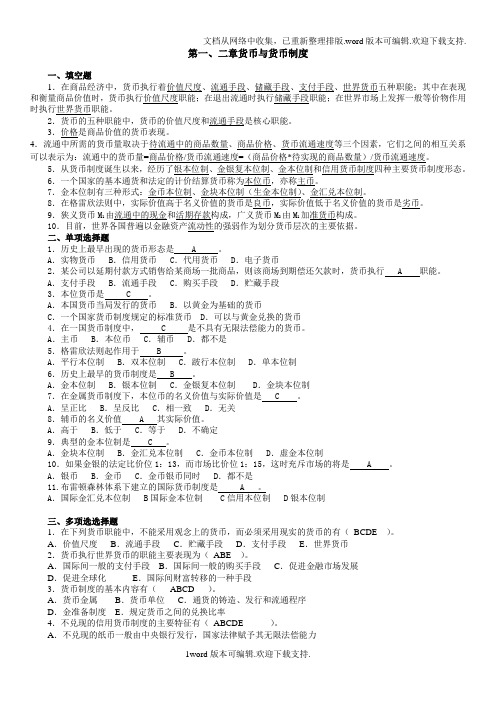
第一、二章货币与货币制度一、填空题1.在商品经济中,货币执行着价值尺度、流通手段、储藏手段、支付手段、世界货币五种职能;其中在表现和衡量商品价值时,货币执行价值尺度职能;在退出流通时执行储藏手段职能;在世界市场上发挥一般等价物作用时执行世界货币职能。
2.货币的五种职能中,货币的价值尺度和流通手段是核心职能。
3.价格是商品价值的货币表现。
4.流通中所需的货币量取决于待流通中的商品数量、商品价格、货币流通速度等三个因素,它们之间的相互关系可以表示为:流通中的货币量=商品价格/货币流通速度=(商品价格*待实现的商品数量)/货币流通速度。
5.从货币制度诞生以来,经历了银本位制、金银复本位制、金本位制和信用货币制度四种主要货币制度形态。
6.一个国家的基本通货和法定的计价结算货币称为本位币,亦称主币。
7.金本位制有三种形式:金币本位制、金块本位制(生金本位制)、金汇兑本位制。
8.在格雷欣法则中,实际价值高于名义价值的货币是良币,实际价值低于名义价值的货币是劣币。
9.狭义货币M1由流通中的现金和活期存款构成,广义货币M2由M1加准货币构成。
10.目前,世界各国普遍以金融资产流动性的强弱作为划分货币层次的主要依据。
二、单项选择题1.历史上最早出现的货币形态是 A 。
A.实物货币 B.信用货币 C.代用货币 D.电子货币2.某公司以延期付款方式销售给某商场一批商品,则该商场到期偿还欠款时,货币执行 A 职能。
A.支付手段 B.流通手段 C.购买手段 D.贮藏手段3.本位货币是 C 。
A.本国货币当局发行的货币 B.以黄金为基础的货币C.一个国家货币制度规定的标准货币 D.可以与黄金兑换的货币4.在一国货币制度中, C 是不具有无限法偿能力的货币。
A.主币 B.本位币 C.辅币 D.都不是5.格雷欣法则起作用于 B 。
A.平行本位制 B.双本位制 C.跛行本位制 D.单本位制6.历史上最早的货币制度是 B 。
A.金本位制 B.银本位制 C.金银复本位制 D.金块本位制7.在金属货币制度下,本位币的名义价值与实际价值是 C 。
货币银行学(第六版)章节练习题及答案1-13章全
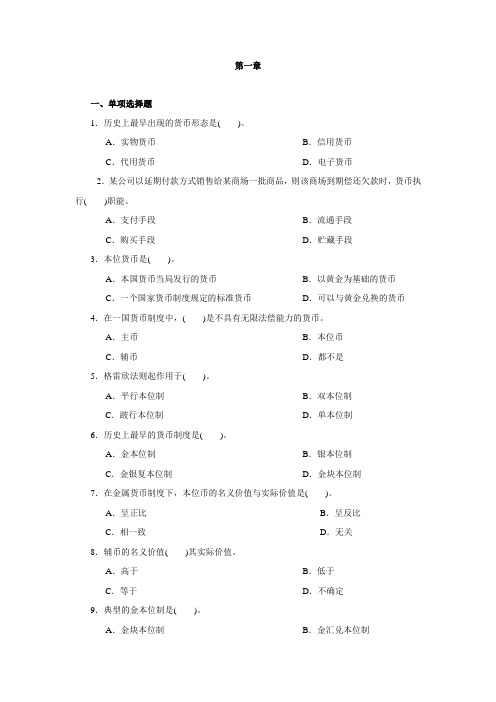
第一章一、单项选择题1.历史上最早出现的货币形态是()。
A.实物货币B.信用货币C.代用货币D.电子货币2.某公司以延期付款方式销售给某商场一批商品,则该商场到期偿还欠款时,货币执行()职能。
A.支付手段B.流通手段C.购买手段D.贮藏手段3.本位货币是()。
A.本国货币当局发行的货币B.以黄金为基础的货币C.一个国家货币制度规定的标准货币D.可以与黄金兑换的货币4.在一国货币制度中,()是不具有无限法偿能力的货币。
A.主币B.本位币C.辅币D.都不是5.格雷欣法则起作用于()。
A.平行本位制B.双本位制C.跛行本位制D.单本位制6.历史上最早的货币制度是()。
A.金本位制B.银本位制C.金银复本位制D.金块本位制7.在金属货币制度下,本位币的名义价值与实际价值是()。
A.呈正比B.呈反比C.相一致D.无关8.辅币的名义价值()其实际价值。
A.高于B.低于C.等于D.不确定9.典型的金本位制是()。
A.金块本位制B.金汇兑本位制C.金币本位制D.虚金本位制10.如果金银的法定比价为1∶13,而市场比价为1∶15,这时充斥市场的将是()。
A.银币B.金币C.金币和银币D.都不是二、多项选择题1.货币最早具有的基本职能有()。
A.价值尺度B.流通手段C.贮藏手段D.支付手段E.世界货币2.货币执行世界货币的职能主要表现为()。
A.国家间一般的支付手段B.国家间一般的流通手段C.促进金融市场发展D.促进全球化E.国家间财富转移的一种手段3.货币制度的基本内容有()。
A.货币金属B.货币单位C.通货的铸造、发行和流通程序D.金准备制度E.规定货币之间的兑换比率4.不兑现的信用货币制度的主要特征有()。
A.不兑现的纸币一般由中央银行发行,国家法律赋予其无限法偿能力B.纸币不与金银保持等价关系C.货币通过银行的信贷程序发行D.银行存款也是通货E.黄金完全退出货币流通5.下列属于辅币的特点的有()。
A.专供日常零星支付B.实际价值低于其名义价值C.可以自由铸造D.是有限法偿货币E.国家垄断铸造6.在我国货币层次中,准货币是指()。
货币银行学习题及答案
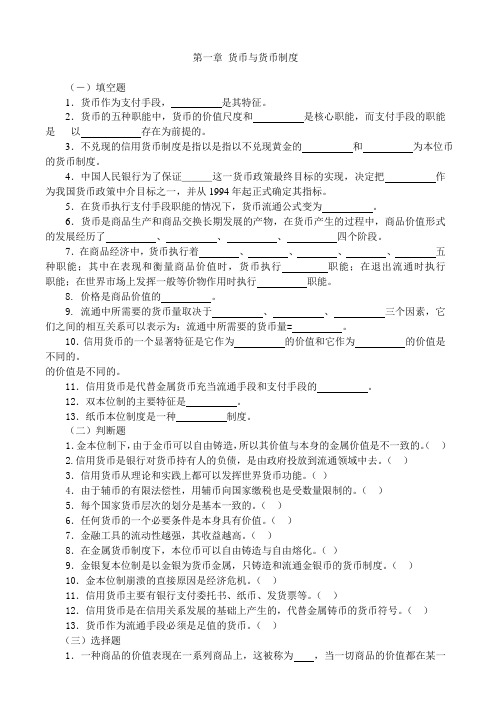
第一章货币与货币制度(-)填空题1.货币作为支付手段,是其特征。
2.货币的五种职能中,货币的价值尺度和是核心职能,而支付手段的职能是以存在为前提的。
3.不兑现的信用货币制度是指以是指以不兑现黄金的和为本位币的货币制度。
4.中国人民银行为了保证___这一货币政策最终目标的实现,决定把作为我国货币政策中介目标之一,并从1994年起正式确定其指标。
5.在货币执行支付手段职能的情况下,货币流通公式变为。
6.货币是商品生产和商品交换长期发展的产物,在货币产生的过程中,商品价值形式的发展经历了、、、四个阶段。
7.在商品经济中,货币执行着、、、、五种职能;其中在表现和衡量商品价值时,货币执行职能;在退出流通时执行职能;在世界市场上发挥一般等价物作用时执行职能。
8. 价格是商品价值的。
9. 流通中所需要的货币量取决于、、三个因素,它们之间的相互关系可以表示为:流通中所需要的货币量= 。
10.信用货币的一个显著特征是它作为的价值和它作为的价值是不同的。
的价值是不同的。
11.信用货币是代替金属货币充当流通手段和支付手段的。
12.双本位制的主要特征是。
13.纸币本位制度是一种制度。
(二)判断题1.金本位制下,由于金币可以自由铸造,所以其价值与本身的金属价值是不一致的。
() 2.信用货币是银行对货币持有人的负债,是由政府投放到流通领域中去。
()3.信用货币从理论和实践上都可以发挥世界货币功能。
()4.由于辅币的有限法偿性,用辅币向国家缴税也是受数量限制的。
()5.每个国家货币层次的划分是基本一致的。
()6.任何货币的一个必要条件是本身具有价值。
()7.金融工具的流动性越强,其收益越高。
()8.在金属货币制度下,本位币可以自由铸造与自由熔化。
()9.金银复本位制是以金银为货币金属,只铸造和流通金银币的货币制度。
()10.金本位制崩溃的直接原因是经济危机。
()11.信用货币主要有银行支付委托书、纸币、发货票等。
()12.信用货币是在信用关系发展的基础上产生的,代替金属铸币的货币符号。
《货币银行学》试题库(附答案)精选全文完整版

可编辑修改精选全文完整版《货币银行学》试题库(附答案)一、单项选择题:1.(在多种利率并存的条件下起决定作用的利率是( A )A. 基准利率 B(差别利率 C. 实际利率 D(公定利率2. 执行价值单方向转移的货币职能是(C)A. 价值尺度B. 流通手段C. 支付手段D. 贮藏手段3. 商业银行最主要的资金来源是(D)A. 资本金B. 中央银行借款C. 发行金融债券D. 存款负债4. 商业信用中所使用的信用工具是( D )A.存折B.股票C.债券D.票据5. 企业之间的商品赊销、赊购行为属于( A )A.商业信用B.银行信用C.国家信用D.消费信用6. “劣币驱逐良币”现象发生在( C )制度下。
A.银本位B.金本位C.金银复本位D.纸币本位7. 债券的发行价格高于债券的票面额称为( C )。
A.折价发行B.中间价发行C.溢价发行D.平价发行8. 股票是一种永久性的证券,它是( B )A.债券凭证B.所有权凭证C.使用权凭证D.实物资本9. 比一般贷款利率低,用于国家政策扶持对象的贷款利率是( C )A.市场利率B.实际利率C.优惠利率D.名义利率10. 中央银行宏观调控的主要手段是( C )A.产业政策B.财政政策C.货币政策D.收入政策11. 由市场资金供求关系所决定的利率为 ( C )A.实际利率B.名义利率C.市场利率D.官定利率12. 商业银行负债业务中最主要的部分是( A )A.各项存款B.同业拆借C.自有资本D.向中央银行借款13. 中央银行的再贴现利率和再贷款利率可称为( B )A.优惠利率B.基准利率C.差别利率D.实际利率14. 我国货币层次划分中的M0是指( D )A. 储蓄B.存款C.信用卡存款D.现金15. 属于区域性国际金融机构的是( B )A.世界银行B.亚洲开发银行C.国际金融公司D.农业发展基金会16. 属于货币政策远期中介指标的是( B )A(汇率 B(超额准备金 C(利率 D(基础货币17. 导致通货膨胀的直接原因是( D )。
货币银行学章节题库答案

《货币银行学》题库第一章导言(略)第二章货币与货币制度一、填空1、从货币本质出发,货币是固定充当()的特殊商品;从价值规律的角度看,货币是核算()的工具。
答案:一般等价物2、古今中外很多思想家和经济学家都看到了货币的起源与()的联系。
答案:交换发展3、银行券是随着()的发展而出现的一种用纸印制的货币。
答案:资本主义银行4、铸币的发展有一个从足值到()铸币的过程。
答案:不足值5、用纸印制的货币产生于货币的()职能。
答案:流通手段6、价格是()的货币表现。
答案:价值7、存储于银行电子计算机系统内可利用银行卡随时提取现金或支付的存款货币称为()。
答案:电子货币8、货币在商品交换中起媒介作用时发挥的是()职能。
答案:流通手段9、在金属货币流通条件下货币贮藏具有()的作用。
答案:自发调节货币数量10、一国流通中标准的基本通货是()。
答案:本位币11、没有商品(劳务)在同时、同地与之作相向运动是货币发挥()职能的特征。
答案:支付手段12、至今为止历史上最理想的货币制度通常被认为是()。
答案:金铸币本位制13、我国的人民币是从()开始发行的。
答案:1948年12月1日14、人民币采取的是()银行券的形式。
答案:不兑现15、欧元的出现对()提出了挑战。
答案:国家货币主权二、单项选择题:1、与货币的出现紧密相联的是()A、金银的稀缺性B、交换产生与发展C、国家的强制力D、先哲的智慧答案:B2、商品价值形式最终演变的结果是()A、简单价值形式B、扩大价值形式C、一般价值形式D、货币价值形式答案:D3、中国最早的铸币金属是()A、铜B、银C、铁D、贝答案:A4、在下列货币制度中劣币驱逐良币律出现在()A、金本位制B、银本位制C、金银复本位制D、金汇兑本位制答案:C5、中华人民共和国货币制度建立于()A、1948年B、1949年C、1950年D、1951年答案:A6、欧洲货币同盟开始使用“欧元EURO”于()A、1998年B、1999年C、2001年D、2002年答案:B7、金银复本位制的不稳定性源于()A、金银的稀缺B、生产力的迅猛提高C、货币发行管理混乱D、金银同为本位币答案:D8、中国本位币的最小规格是()A、1分B、1角C、1元D、10元答案:C9、金属货币制度下的蓄水池功能源于()A、金属货币的稀缺性B、金属货币的价值稳定C、金属货币的自由铸造和熔化D、金属货币的易于保存答案:C10、单纯地从物价和货币购买力的关系看,物价指数上升25%,则货币购买力()A、上升20%B、下降20%C、上升25%D、下降25% 答案:B11、在国家财政和银行信用中发挥作用的主要货币职能是()A、价值尺度B、流通手段C、支付手段D、贮藏手段答案:C12、下列货币制度中最稳定的是()A、银本位制B、金银复本位制C、金铸币本位制D、金汇兑本位制答案:C13、马克思的货币本质观的建立基础是()A、劳动价值说B、货币金属说C、货币名目说D、创造发明说答案:A14、对商品价格的理解正确的是()A、同商品价值成反比B、同货币价值成正比C、商品价值的货币表现D、商品价值与货币价值的比答案:C15、货币的本质特征是充当()A、特殊等价物B、一般等价物C、普通商品D、特殊商品答案:B二、多项选择题1、一般而言,要求作为货币的商品具有如下特征()A、价值比较高B、金属的一种C、易于分割D、易于保存E、便于携带答案:ACDE2、中国最古老的铜铸币的三种形制是()A、五铢B、布C、刀D、元宝E、铜贝答案:BCE3、信用货币包括()A、银行券B、支票C、活期存款D、商业票据E、定期存款答案:ABCDE4、货币支付职能发挥作用的场所有()A、赋税B、各种劳动报酬C、国家财政D、银行信用E、地租答案:ABCDE5、对本位币的理解正确的是()A、本位币是一国的基本通货B、本位币具有有限法偿C、本位币具有无限法偿D、本位币的最小规格是一个货币单位E、本位币具有排他性答案:ABCDE6、信用货币制度的特点有()A、黄金作为货币发行的准备B、贵金属非货币化C、国家强制力保证货币的流通D、金银储备保证货币的可兑换性E、货币发行通过信用渠道答案:BCE7、货币的两个基本职能是()A、流通手段B、支付手段C、贮藏手段D、世界货币E、价值尺度答案:AE8、对货币单位的理解正确的有()A、国家法定的货币计量单位B、规定了货币单位的名称C、规定本位币的币材D、确定技术标准E、规定货币单位所含的货币金属量答案:ABE9、我国货币制度规定人民币具有以下的特点()A、人民币是可兑换货币B、人民币与黄金没有直接联系C、人民币是信用货币D、人民币具有无限法偿力E、人民币具有有限法偿力答案:BCD10、货币制度的基本类型有()A、银本位制B、金银复本位制C、金本位制D、信用本位制E、银行券本位制答案:ABCD三、判断题1、最早的货币形式是金属铸币。
货币银行学第13章纸质练习(附答案) - 副本
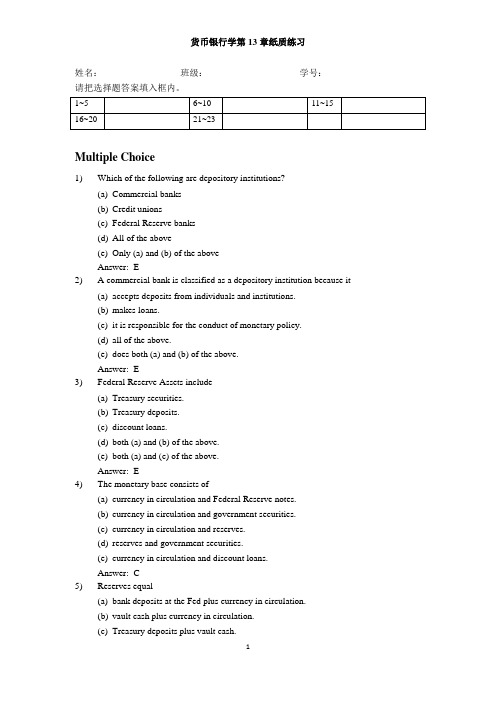
货币银行学第13章纸质练习姓名:班级:学号:请把选择题答案填入框内。
Multiple Choice1)Which of the following are depository institutions?(a)Commercial banks(b)Credit unions(c)Federal Reserve banks(d)All of the above(e)Only (a) and (b) of the aboveAnswer:E2) A commercial bank is classified as a depository institution because it(a)accepts deposits from individuals and institutions.(b)makes loans.(c)it is responsible for the conduct of monetary policy.(d)all of the above.(e)does both (a) and (b) of the above.Answer:E3)Federal Reserve Assets include(a)Treasury securities.(b)Treasury deposits.(c)discount loans.(d)both (a) and (b) of the above.(e)both (a) and (c) of the above.Answer:E4)The monetary base consists of(a)currency in circulation and Federal Reserve notes.(b)currency in circulation and government securities.(c)currency in circulation and reserves.(d)reserves and government securities.(e)currency in circulation and discount loans.Answer:C5)Reserves equal(a)bank deposits at the Fed plus currency in circulation.(b)vault cash plus currency in circulation.(c)Treasury deposits plus vault cash.(d)Treasury deposits plus bank deposits at the Fed.(e)vault cash plus bank deposits at the Fed.Answer:E6)An increase in government securities held by the Fed leads to(a)an increase in the monetary base.(b)an increase in the money supply.(c)a decline in the money supply.(d)only (a) and (b) of the above.Answer:D7)By making discount loans(a)the Fed provides reserves to the banking system.(b)the Fed earns interest income.(c)the Treasury increases its deposits.(d)all of the above.(e)both (a) and (b) of the above.Answer:E8) A decrease in discount loans by the Fed leads to(a)a decline in the monetary base.(b)an increase in the money base.(c)a decline in the money supply.(d)only (a) and (b) of the above.(e)only (a) and (c) of the above.Answer:E9)When the Fed buys $100 worth of bonds from the First National Bank, reserves in thebanking system(a)increase by $100.(b)increase by more than $100.(c)decrease by $100.(d)decrease by more than $100.Answer:A10)When the Fed purchases $100 of bonds from a bank, the bank may either deposit thecheck it receives in its account with the Fed or cash it for currency, which will becounted as vault cash. Either action means that the bank will find itself with(a)additional reserves.(b)more assets.(c)both (a) and (b).(d)none of the above.Answer:A11)If a member of the nonbank public sells a government bond to the Federal Reserve inexchange for currency,(a)the monetary base will rise.(b)reserves will remain unchanged.(c)reserves will rise.(d)both (a) and (b) of the above will occur.Answer:D12)If a member of the nonbank public purchases a government bond from the FederalReserve with currency,(a)reserves will fall.(b)the monetary base will fall.(c)reserves will remain unchanged.(d)both (a) and (b) will occur.(e)both (b) and (c) will occur.Answer:E13)When the Federal Reserve extends a discount loan to a bank,(a)both the monetary base and reserves increase.(b)the increase in the monetary base equals the increase in the borrowed base.(c)the monetary base changes two-for-one with the change in borrowings from theFed.(d)only (a) and (b) of the above occur.Answer:D14)When the Fed wants to increase the level of reserves of the banking system, it can(a)buy government bonds from the general public.(b)buy government bonds from banks.(c)issue government bonds.(d)do any of the above.(e)do only (a) and (b) of the above.Answer:E15) A sale of government bonds by the Fed(a)is called an open market sale.(b)increases the monetary base, all else being the same.(c)reduces the discount loans, all else being the same.(d)does only (a) and (b) of the above.(e)does only (a) and (c) of the above.Answer:A16)An increase in which of the following leads to an increase in the monetary base?(a)Float(b)Foreign currency deposits(c)U.S. Treasury deposits at the Fed(d)All of the above(e)Only (a) and (b) of the aboveAnswer:E17)Factors that cause the monetary base to decline include(a)a decrease in the Fed’s holding of Treasury securities.(b)a decrease in the Fed’s holding of discount loans.(c)an increase in Treasury currency outstanding.(d)only (a) and (b) of the aboveAnswer:D18)Which of the following are true statements concerning the monetary base?(a)The factor that most affects the monetary base is the Fed’s holdings of securities,which are completely controlled by the Fed through its open market operations.(b)Factors not controlled by the Fed (e.g., float) undergo substantial short-runvariations and can be important sources of fluctuations in the monetary base overtime periods as short as a week.(c)Although float and Treasury deposits at the Fed undergo substantial short-runfluctuation, which complicates control of the monetary base, they do not preventthe Fed from accurately controlling it.(d)All of the above are true.Answer:D19)If the required reserve ratio is equal to 20 percent, then a single bank can increase itsloans up to a maximum amount equal to(a)five times its excess reserves.(b)20 percent of its excess reserves.(c)2 1/2 times its excess reserves.(d)none of the above.Answer:D20)The First National Bank of Hometown has excess reserves of $150. Assuming arequired reserve ratio of 10%, the First National Bank can lend(a)$1500.(b)$750.(c)$150.(d)$135.(e)$0.Answer:C21)In the simple model of multiple deposit creation in which banks do not hold excessreserves, the increase in checkable deposits equals the product of the change in excess reserves and the(a)reciprocal of the excess reserve ratio.(b)the simple deposit expansion multiplier.(c)reciprocal of the simple deposit multiplier.(d)discount rate.Answer:B22)If the required reserve ratio is 15 percent, the simple deposit multiplier is approximately(a)15.0.(b)1.5.(c)6.67.(d)3.33.23)If the banking system has excess reserves of $75, and the required reserve ratio is 20%,the potential expansion of checkable deposits is(a)$75.(b)$750.(c)$37.50.(d)$375.(e)$0.Answer:D24)In the simple deposit expansion model, an expansion in checkable deposits of $1,000when the required reserve ratio is equal to 20 percent implies that the Fed(a)sold $200 in government bonds.(b)sold $500 in government bonds.(c)purchased $200 in government bonds.(d)purchased $500 in government bonds.Answer:C25)If reserves in the banking system increase by $100, then checkable deposits willincrease by $400 in the simple model of deposit creation when the required reserveratio is(a)0.01.(b)0.10.(c)0.25.(d)0.20.Answer:C26)If a bank has excess reserves of $20,000 and demand deposit liabilities of $80,000, andif the reserve requirement is 20 percent, then the bank has total reserves of(a)$16,000.(b)$6,000.(c)$26,000.(d)$20,000.(e)$36,000.Answer:E27)If a bank has excess reserves of $7,000 and demand deposit liabilities of $100,000, andif the reserve requirement is 10 percent, then the bank has actual reserves of(a)$27,000.(b)$17,000.(c)$14,000.(d)$22,000.Answer:B28) A bank has excess reserves of $1,000 and demand deposit liabilities of $80,000 whenthe reserve requirement is 25 percent. If the reserve requirement is lowered to 20percent, the bank’s excess reserves will be(b)$5,000.(c)$8,000.(d)$9,000.Answer:B29)For a banking system with no excess reserves, a shift from deposits to currency held bythe public(a)decreases bank reserves.(b)decreases bank deposits.(c)decreases bank loans.(d)all of the above.(e)both (a) and (b) of the above.Answer:D30)For a banking system with no excess reserves, a shift from currency to deposits held bythe public(a)decreases bank reserves.(b)increases the monetary base.(c)increases potential bank loans.(d)all of the above.(e)both (a) and (b) of the above.Answer:C31)Decisions by depositors to increase their holdings of _____, or of banks to hold _____reserves will result in a _____ expansion of deposits than the simple model predicts.(a)deposits; excess; smaller(b)deposits; required; larger(c)currency; excess; smaller(d)currency; required; largerAnswer:C32)For a banking system with no excess reserves, a shift from currency to deposits held bythe public(a)increases bank reserves.(b)increases the monetary base.(c)increases Fed holdings of foreign currency deposits.(d)all of the above.(e)both (a) and (b) of the above.Answer:A33) A bank has excess reserves of $10,000 and demand deposit liabilities of $100,000 whenthe required reserve ratio is 20 percent. If the reserve ratio is raised to 25 percent, thebank’s excess reserves will be(a)$1,000.(b)-$1,000.(c)$5,000.(d)-$5,000.Essay QuestionsAssume that no banks hold excess reserves, and the public holds no currency. If a bank sells a $100 security to the Fed, show, using T-accounts, what happens to this bank and two additional steps in the deposit expansion process, assuming a 10% reserve requirement.How much do deposits and loans increase for the banking system when the process is completed?Answer:The bank first changes a security for reserves, and then lends the reserves, creating loans.Step 1Bank AStep 2Bank ANext, the proceeds are deposited in Bank B, and then Bank B lends it $90 ofexcess reserves.Step 3Bank BStep 4Bank BNext, the loan proceeds are deposited in Bank C, which then lends its excess reservesStep 5Bank CStep 6Bank CFor the banking system, both loans and deposits increase by $1000.。
货币银行学试题与答案(doc 14页)
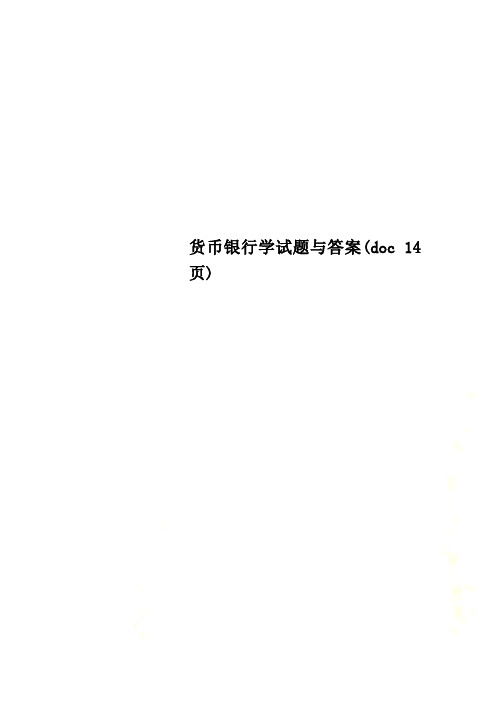
货币银行学试题与答案(doc 14页)款2.在影响基础货币增减变动的因素中,( ) 的影响最为主要。
A. 国外净资产B. 中央银行对政府债权C. 固定资产的增减变化D.中央银行对商业银行的债权3.对货币政策中介指标理想值的确定是指规定一个( )。
A.无弹性的固定数值 B..区值C. 随机值D.有弹性的固定数值4.货币均衡的自发实现主要依*( )。
A. 价格机制B. 中央银行宏观调控C. 利率机制D.汇率机制5.实行( )是当前国际货币体系的主要特征之一。
A.固定汇率 B. 浮动汇率C. 钉住汇率D.一揽子汇率6.导致通货膨胀的直接原因是( )A. 货币贬值B. 纸币流通C. 物价上涨D.货币供应过多7.下列哪个方程式中( )是马克思的货币必要量公式。
A.MV=PT B.P=MV/T C. M;PQ/V D.M‘KPY8.货币均衡的自发实现主要依*( )A. 价格机制B. 汇率机制C. 利率机制D.中央银行宏观调控9.在下列控制经济中货币总量的各个手段中,中央银行不能完全自主操作的是:( )A. 公开市场业务B. 再贴现政策C.信贷规模控制D.法定准备金率10.在多种利率并存的条件下起决定作用的利率是( )A. 基准利率B.差别利率 C. 实际利率D.公定利率四、多项选择题(每小题2分,共20分。
每小题有数目不等的答案正确,请将所有正确答案的序号填写在括号内) 1.国家信用的主要形式有( )。
A.发行国家公愤B.发行国库券C.发行专项债券D.向中央银行透支或借款 E. 出口信贷2.利率作为经济杠杆,在经济中发挥着以下功能( )。
A.中介功能B.分配功能C. 调节功能D.国际经济功能E.控制功能3.我国利率的决定与影响因素有( )。
A. 资金的供求状况B.国际经济的环境 C. 利润的平均水平 D.政策性因素E.物价变动的幅度4.影响我国货币需求的因素有( )。
A.价格B.收入C. 利率D.货币流通速度E.金融资产收益率5.按照外汇的支付方式,可将汇率分为( )。
货币银行学练习题
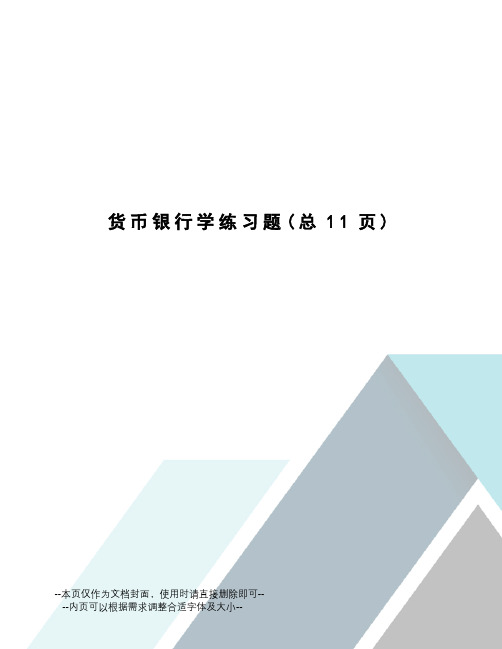
货币银行学练习题(总11页)--本页仅作为文档封面,使用时请直接删除即可----内页可以根据需求调整合适字体及大小--货币银行学练习题第一章判断题:1、与货币的起源密不可分的是贫富分化。
2、价格标准是各种商品在质上同一、在量上可以比较的共同基础。
3、用纸做的货币,比如银行券和国家发行的纸币,在性质上都是一致的。
4 、钱、货币、通货、现金都是一回事,银行卡也是货币。
5 、发挥支付手段职能的货币同发挥流通手段职能的货币一样,都是处于流通过程中的现实的货币。
所谓流通中的货币,指的就是这两者的总体。
流通中的任一货币,往往是交替地发挥这两种职能。
6 、在现在的经济文献中,“流动性”指的就是货币。
7 、在铸币铸造方面,资本主义经济登上历史舞台,产生了自由铸造制度。
所谓“自由铸造”,是指公民有权按照自身的意愿私自铸造。
不定项选择:1 、马克思关于货币起源的论述,是以如下哪种理论为依据的?A 、货币价值论B 、货币数量论C 、国家政权决定论D 、劳动价值论2 、马克思主要是通过分析如下哪一要素的发展,来揭示货币产生的客观必然性的?A 、经济体制B 、使用价值形式C 、价值形式D 、社会形态3 、与货币的起源密不可分的是:A 、私有制B 、社会分工C 、贫富分化D 、商品交换4 、不同商品在量上可以比较、在质上同一的共同基础是:A 、价格标准B 、使用价值C 、价值D 、价格5 、属于物物的直接交换的价值形式包括:A 、一般的价值形式 B 、特殊的价值形式 C 、简单的价值形式 D 、扩大的价值形式6 、最初的货币所采取的形态是:A 、金币、银币 B 、牲畜、皮革、烟草 C 、纸币 D 、银行券7 、货币的各种职能都是从现实的货币出发来描述的,但可用货币符号来代替的是:A 、流通手段 B 、价值尺度 C 、储藏手段D 、支付手段8 、货币支付手段职能最初是导源于:A 、支付工资 B 、商品赊销 C 、吸收存款 D 、发放贷款12 、作为流通手段职能的货币是:A 、价值符号B 、现实的货币C 、信用货币D 、观念上的货币13 、在发达的商品经济中,支付手段发挥作用的主要场所是:A 、信贷收支B 、支付工资C 、财政收支D 、大额交易14 、以下属于货币发挥支付手段职能的有:A 、银行吸收存款B 、汽车购买C 、工资支付D 、商品购买15 、经济对货币的需求包括对:A 、世界货币的需求B 、储藏手段的需求C 、流通手段的需求D 、支付手段的需求第二章三、判断1 、信用的形式特征是以收回为条件的付出,或以归还为义务的取得;而且贷者之所以贷出,是因为有权取得利息 (interest) 。
(完整版)货币银行学_习题集(含答案)
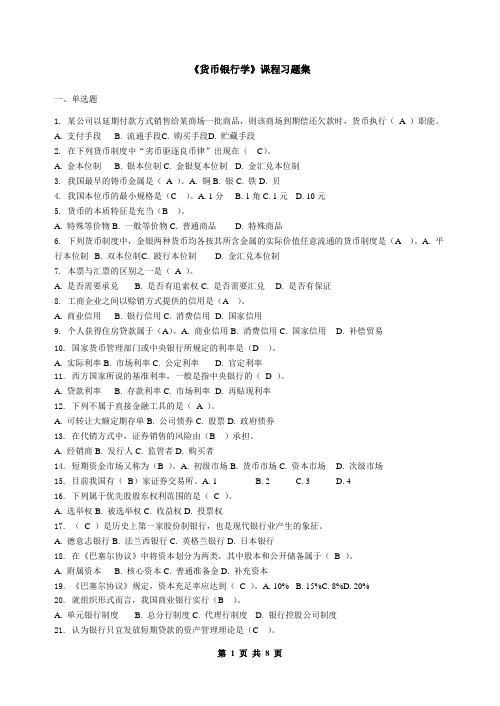
《货币银行学》课程习题集一、单选题1.某公司以延期付款方式销售给某商场一批商品,则该商场到期偿还欠款时,货币执行( A )职能。
A. 支付手段B. 流通手段C. 购买手段D. 贮藏手段2.在下列货币制度中“劣币驱逐良币律”出现在(C)。
A. 金本位制B. 银本位制C. 金银复本位制D. 金汇兑本位制3.我国最早的铸币金属是(A )。
A. 铜B. 银C. 铁D. 贝4.我国本位币的最小规格是(C )。
A. 1分 B. 1角C. 1元 D. 10元5.货币的本质特征是充当(B )。
A. 特殊等价物B. 一般等价物C. 普通商品D. 特殊商品6.下列货币制度中,金银两种货币均各按其所含金属的实际价值任意流通的货币制度是(A )。
A. 平行本位制 B. 双本位制C. 跛行本位制 D. 金汇兑本位制7.本票与汇票的区别之一是(A )。
A. 是否需要承兑B. 是否有追索权C. 是否需要汇兑D. 是否有保证8.工商企业之间以赊销方式提供的信用是(A )。
A. 商业信用B. 银行信用C. 消费信用D. 国家信用9.个人获得住房贷款属于(A)。
A. 商业信用B. 消费信用C. 国家信用 D. 补偿贸易10.国家货币管理部门或中央银行所规定的利率是(D )。
A. 实际利率B. 市场利率C. 公定利率D. 官定利率11.西方国家所说的基准利率,一般是指中央银行的( D )。
A. 贷款利率B. 存款利率C. 市场利率D. 再贴现利率12.下列不属于直接金融工具的是( A )。
A. 可转让大额定期存单B. 公司债券C. 股票D. 政府债券13.在代销方式中,证券销售的风险由(B )承担。
A. 经销商B. 发行人C. 监管者D. 购买者14.短期资金市场又称为(B )。
A. 初级市场B. 货币市场C. 资本市场 D. 次级市场15.目前我国有(B)家证券交易所。
A. 1 B. 2 C. 3 D. 416.下列属于优先股股东权利范围的是( C )。
货币银行学金的融学逢考必过含详细答案各章节知识点总结及习题
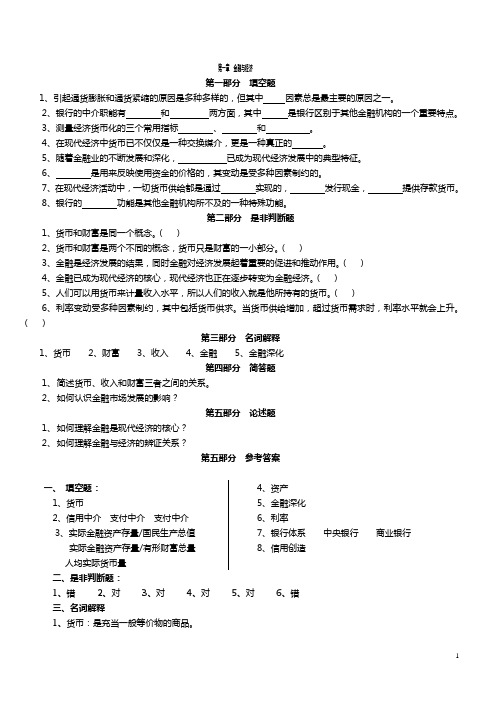
第一章金融与经济第一部分填空题1、引起通货膨胀和通货紧缩的原因是多种多样的,但其中因素总是最主要的原因之一。
2、银行的中介职能有和两方面,其中是银行区别于其他金融机构的一个重要特点。
3、测量经济货币化的三个常用指标、和。
4、在现代经济中货币已不仅仅是一种交换媒介,更是一种真正的。
5、随着金融业的不断发展和深化,已成为现代经济发展中的典型特征。
6、是用来反映使用资金的价格的,其变动是受多种因素制约的。
7、在现代经济活动中,一切货币供给都是通过实现的,发行现金,提供存款货币。
8、银行的功能是其他金融机构所不及的一种特殊功能。
第二部分是非判断题1、货币和财富是同一个概念。
()2、货币和财富是两个不同的概念,货币只是财富的一小部分。
()3、金融是经济发展的结果,同时金融对经济发展起着重要的促进和推动作用。
()4、金融已成为现代经济的核心,现代经济也正在逐步转变为金融经济。
()5、人们可以用货币来计量收入水平,所以人们的收入就是他所持有的货币。
()6、利率变动受多种因素制约,其中包括货币供求。
当货币供给增加,超过货币需求时,利率水平就会上升。
()第三部分名词解释1、货币2、财富3、收入4、金融5、金融深化第四部分简答题1、简述货币、收入和财富三者之间的关系。
2、如何认识金融市场发展的影响?第五部分论述题1、如何理解金融是现代经济的核心?2、如何理解金融与经济的辨证关系?第五部分参考答案一、填空题:1、货币2、信用中介支付中介支付中介3、实际金融资产存量/国民生产总值实际金融资产存量/有形财富总量人均实际货币量4、资产5、金融深化6、利率7、银行体系中央银行商业银行8、信用创造二、是非判断题:1、错2、对3、对4、对5、对6、错三、名词解释1、货币:是充当一般等价物的商品。
2、收入(income):是指一个人或一个家庭在一定时期(通常为一年)内的全部进帐和现金收入。
所有收入的总和是国民收入,包括劳动收入和财产收入。
货币银行学课后答案
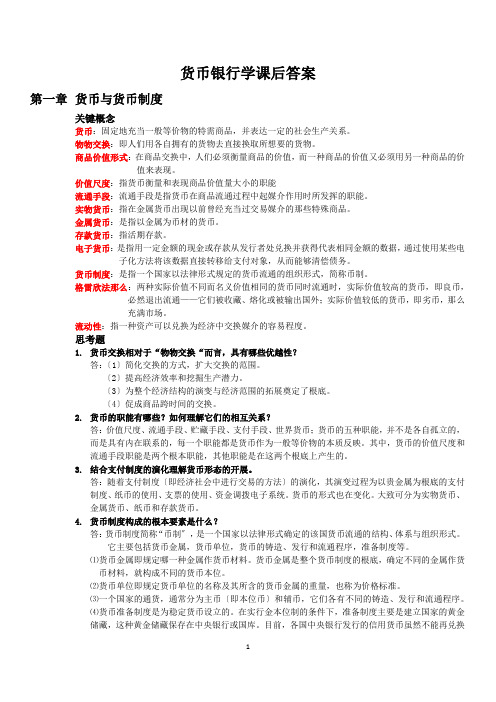
货币银行学课后答案第一章货币与货币制度关键概念货币:固定地充当一般等价物的特需商品,并表达一定的社会生产关系。
物物交换:即人们用各自拥有的货物去直接换取所想要的货物。
商品价值形式:在商品交换中,人们必须衡量商品的价值,而一种商品的价值又必须用另一种商品的价值来表现。
价值尺度:指货币衡量和表现商品价值量大小的职能流通手段:流通手段是指货币在商品流通过程中起媒介作用时所发挥的职能。
实物货币:指在金属货币出现以前曾经充当过交易媒介的那些特殊商品。
金属货币:是指以金属为币材的货币。
存款货币:指活期存款。
电子货币:是指用一定金额的现金或存款从发行者处兑换并获得代表相同金额的数据,通过使用某些电子化方法将该数据直接转移给支付对象,从而能够清偿债务。
货币制度:是指一个国家以法律形式规定的货币流通的组织形式,简称币制。
格雷欣法那么:两种实际价值不同而名义价值相同的货币同时流通时,实际价值较高的货币,即良币,必然退出流通——它们被收藏、熔化或被输出国外;实际价值较低的货币,即劣币,那么充满市场。
流动性:指一种资产可以兑换为经济中交换媒介的容易程度。
思考题1.货币交换相对于“物物交换“而言,具有哪些优越性?答:〔1〕简化交换的方式,扩大交换的范围。
〔2〕提高经济效率和挖掘生产潜力。
〔3〕为整个经济结构的演变与经济范围的拓展奠定了根底。
〔4〕促成商品跨时间的交换。
2.货币的职能有哪些?如何理解它们的相互关系?答:价值尺度、流通手段、贮藏手段、支付手段、世界货币;货币的五种职能,并不是各自孤立的,而是具有内在联系的,每一个职能都是货币作为一般等价物的本质反映。
其中,货币的价值尺度和流通手段职能是两个根本职能,其他职能是在这两个根底上产生的。
3.结合支付制度的演化理解货币形态的开展。
答:随着支付制度〔即经济社会中进行交易的方法〕的演化,其演变过程为以贵金属为根底的支付制度、纸币的使用、支票的使用、资金调拨电子系统。
货币的形式也在变化。
《货币银行学》习题集 精品全册156页word文档
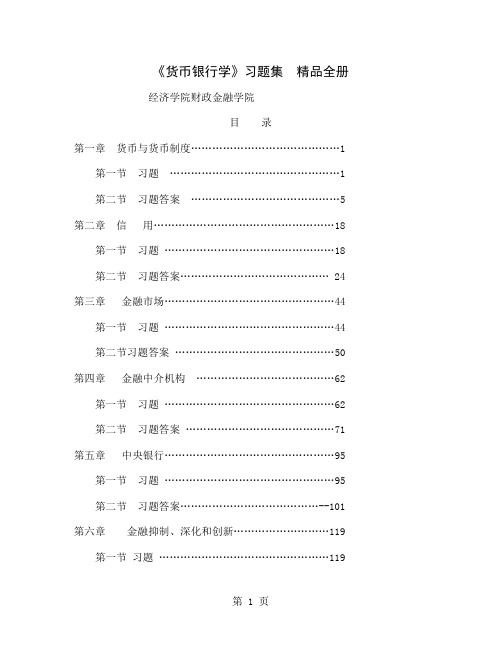
《货币银行学》习题集精品全册经济学院财政金融学院目录第一章货币与货币制度 (1)第一节习题 (1)第二节习题答案 (5)第二章信用 (18)第一节习题 (18)第二节习题答案 (24)第三章金融市场 (44)第一节习题 (44)第二节习题答案 (50)第四章金融中介机构 (62)第一节习题 (62)第二节习题答案 (71)第五章中央银行 (95)第一节习题 (95)第二节习题答案.......................................--101第六章金融抑制、深化和创新 (119)第一节习题 (119)第二节习题答案 (125)第七章货币理论(上) (134)第一节习题 (134)第二节习题答案 (140)第八章货币理论(中) (152)第一节习题 (152)第二节习题答案 (163)第九章货币理论(下) (173)第一节习题 (173)第二节习题答案 (182)第一章货币与货币制度第一节习题(一)填空(1)货币是商品生产和商品交换长期发展的产物,在货币产生的过程中,商品价值形式的发展经了、、、等四个阶段。
(2)在商品经济中,货币执行着、、、、______五种职能;其中在表现和衡量商品价值时,货币执行___职能;在退出流通时执行_______职能;在世界市场上发挥一般等价物作用时执行_______职能。
(3)价格是商品价值的_________。
(4)流通中所需要的货币量取决于____、____、____等三个因素,它们之间的相互关系可以表示为它们之间的相互关系可以表示为:流通中所需货币量=_____________。
(5)信用货币的一个显著特征是它作为_____的价值和它作为_____的价值是不同的。
(6)信用货币是代替金属货币充当流通手段和支付手段的________。
(7)双本位制的主要特征是_______。
(8)纸币本位制度是一种_________制度。
(二)是非判断题(1)任何货币的一个必要条件是本身具有价值。
货币银行学配套练习题及参考答案
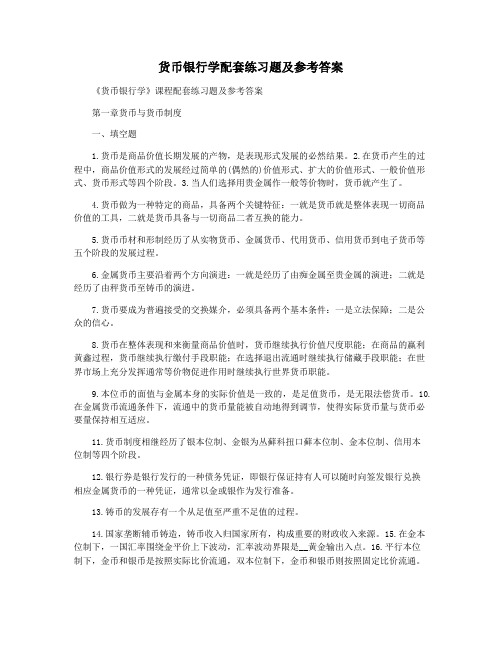
货币银行学配套练习题及参考答案《货币银行学》课程配套练习题及参考答案第一章货币与货币制度一、填空题1.货币是商品价值长期发展的产物,是表现形式发展的必然结果。
2.在货币产生的过程中,商品价值形式的发展经过简单的(偶然的)价值形式、扩大的价值形式、一般价值形式、货币形式等四个阶段。
3.当人们选择用贵金属作一般等价物时,货币就产生了。
4.货币做为一种特定的商品,具备两个关键特征:一就是货币就是整体表现一切商品价值的工具,二就是货币具备与一切商品二者互换的能力。
5.货币币材和形制经历了从实物货币、金属货币、代用货币、信用货币到电子货币等五个阶段的发展过程。
6.金属货币主要沿着两个方向演进:一就是经历了由痴金属至贵金属的演进;二就是经历了由秤货币至铸币的演进。
7.货币要成为普遍接受的交换媒介,必须具备两个基本条件:一是立法保障;二是公众的信心。
8.货币在整体表现和来衡量商品价值时,货币继续执行价值尺度职能;在商品的赢利黄鑫过程,货币继续执行缴付手段职能;在选择退出流通时继续执行储藏手段职能;在世界市场上充分发挥通常等价物促进作用时继续执行世界货币职能。
9.本位币的面值与金属本身的实际价值是一致的,是足值货币,是无限法偿货币。
10.在金属货币流通条件下,流通中的货币量能被自动地得到调节,使得实际货币量与货币必要量保持相互适应。
11.货币制度相继经历了银本位制、金银为丛藓科扭口藓本位制、金本位制、信用本位制等四个阶段。
12.银行券是银行发行的一种债务凭证,即银行保证持有人可以随时向签发银行兑换相应金属货币的一种凭证,通常以金或银作为发行准备。
13.铸币的发展存有一个从足值至严重不足值的过程。
14.国家垄断辅币铸造,铸币收入归国家所有,构成重要的财政收入来源。
15.在金本位制下,一国汇率围绕金平价上下波动,汇率波动界限是__黄金输出入点。
16.平行本位制下,金币和银币是按照实际比价流通,双本位制下,金币和银币则按照固定比价流通。
- 1、下载文档前请自行甄别文档内容的完整性,平台不提供额外的编辑、内容补充、找答案等附加服务。
- 2、"仅部分预览"的文档,不可在线预览部分如存在完整性等问题,可反馈申请退款(可完整预览的文档不适用该条件!)。
- 3、如文档侵犯您的权益,请联系客服反馈,我们会尽快为您处理(人工客服工作时间:9:00-18:30)。
货币银行学第13章纸质练习姓名:班级:学号:请把选择题答案填入框内。
Multiple Choice1)Which of the following are depository institutions?(a)Commercial banks(b)Credit unions(c)Federal Reserve banks(d)All of the above(e)Only (a) and (b) of the aboveAnswer:E2) A commercial bank is classified as a depository institution because it(a)accepts deposits from individuals and institutions.(b)makes loans.(c)it is responsible for the conduct of monetary policy.(d)all of the above.(e)does both (a) and (b) of the above.Answer:E3)Federal Reserve Assets include(a)Treasury securities.(b)Treasury deposits.(c)discount loans.(d)both (a) and (b) of the above.(e)both (a) and (c) of the above.Answer:E4)The monetary base consists of(a)currency in circulation and Federal Reserve notes.(b)currency in circulation and government securities.(c)currency in circulation and reserves.(d)reserves and government securities.(e)currency in circulation and discount loans.Answer:C5)Reserves equal(a)bank deposits at the Fed plus currency in circulation.(b)vault cash plus currency in circulation.(c)Treasury deposits plus vault cash.(d)Treasury deposits plus bank deposits at the Fed.(e)vault cash plus bank deposits at the Fed.Answer:E6)An increase in government securities held by the Fed leads to(a)an increase in the monetary base.(b)an increase in the money supply.(c)a decline in the money supply.(d)only (a) and (b) of the above.Answer:D7)By making discount loans(a)the Fed provides reserves to the banking system.(b)the Fed earns interest income.(c)the Treasury increases its deposits.(d)all of the above.(e)both (a) and (b) of the above.Answer:E8) A decrease in discount loans by the Fed leads to(a)a decline in the monetary base.(b)an increase in the money base.(c)a decline in the money supply.(d)only (a) and (b) of the above.(e)only (a) and (c) of the above.Answer:E9)When the Fed buys $100 worth of bonds from the First National Bank, reserves in thebanking system(a)increase by $100.(b)increase by more than $100.(c)decrease by $100.(d)decrease by more than $100.Answer:A10)When the Fed purchases $100 of bonds from a bank, the bank may either deposit thecheck it receives in its account with the Fed or cash it for currency, which will becounted as vault cash. Either action means that the bank will find itself with(a)additional reserves.(b)more assets.(c)both (a) and (b).(d)none of the above.Answer:A11)If a member of the nonbank public sells a government bond to the Federal Reserve inexchange for currency,(a)the monetary base will rise.(b)reserves will remain unchanged.(c)reserves will rise.(d)both (a) and (b) of the above will occur.Answer:D12)If a member of the nonbank public purchases a government bond from the FederalReserve with currency,(a)reserves will fall.(b)the monetary base will fall.(c)reserves will remain unchanged.(d)both (a) and (b) will occur.(e)both (b) and (c) will occur.Answer:E13)When the Federal Reserve extends a discount loan to a bank,(a)both the monetary base and reserves increase.(b)the increase in the monetary base equals the increase in the borrowed base.(c)the monetary base changes two-for-one with the change in borrowings from theFed.(d)only (a) and (b) of the above occur.Answer:D14)When the Fed wants to increase the level of reserves of the banking system, it can(a)buy government bonds from the general public.(b)buy government bonds from banks.(c)issue government bonds.(d)do any of the above.(e)do only (a) and (b) of the above.Answer:E15) A sale of government bonds by the Fed(a)is called an open market sale.(b)increases the monetary base, all else being the same.(c)reduces the discount loans, all else being the same.(d)does only (a) and (b) of the above.(e)does only (a) and (c) of the above.Answer:A16)An increase in which of the following leads to an increase in the monetary base?(a)Float(b)Foreign currency deposits(c)U.S. Treasury deposits at the Fed(d)All of the above(e)Only (a) and (b) of the aboveAnswer:E17)Factors that cause the monetary base to decline include(a)a decrease in the Fed’s holding of Treasury securities.(b)a decrease in the Fed’s holding of discount loans.(c)an increase in Treasury currency outstanding.(d)only (a) and (b) of the aboveAnswer:D18)Which of the following are true statements concerning the monetary base?(a)The factor that most affects the monetary base is the Fed’s holdings of securities,which are completely controlled by the Fed through its open market operations.(b)Factors not controlled by the Fed (e.g., float) undergo substantial short-runvariations and can be important sources of fluctuations in the monetary base overtime periods as short as a week.(c)Although float and Treasury deposits at the Fed undergo substantial short-runfluctuation, which complicates control of the monetary base, they do not preventthe Fed from accurately controlling it.(d)All of the above are true.Answer:D19)If the required reserve ratio is equal to 20 percent, then a single bank can increase itsloans up to a maximum amount equal to(a)five times its excess reserves.(b)20 percent of its excess reserves.(c)2 1/2 times its excess reserves.(d)none of the above.Answer:D20)The First National Bank of Hometown has excess reserves of $150. Assuming arequired reserve ratio of 10%, the First National Bank can lend(a)$1500.(b)$750.(c)$150.(d)$135.(e)$0.Answer:C21)In the simple model of multiple deposit creation in which banks do not hold excessreserves, the increase in checkable deposits equals the product of the change in excess reserves and the(a)reciprocal of the excess reserve ratio.(b)the simple deposit expansion multiplier.(c)reciprocal of the simple deposit multiplier.(d)discount rate.Answer:B22)If the required reserve ratio is 15 percent, the simple deposit multiplier is approximately(a)15.0.(b)1.5.(c)6.67.(d)3.33.23)If the banking system has excess reserves of $75, and the required reserve ratio is 20%,the potential expansion of checkable deposits is(a)$75.(b)$750.(c)$37.50.(d)$375.(e)$0.Answer:D24)In the simple deposit expansion model, an expansion in checkable deposits of $1,000when the required reserve ratio is equal to 20 percent implies that the Fed(a)sold $200 in government bonds.(b)sold $500 in government bonds.(c)purchased $200 in government bonds.(d)purchased $500 in government bonds.Answer:C25)If reserves in the banking system increase by $100, then checkable deposits willincrease by $400 in the simple model of deposit creation when the required reserveratio is(a)0.01.(b)0.10.(c)0.25.(d)0.20.Answer:C26)If a bank has excess reserves of $20,000 and demand deposit liabilities of $80,000, andif the reserve requirement is 20 percent, then the bank has total reserves of(a)$16,000.(b)$6,000.(c)$26,000.(d)$20,000.(e)$36,000.Answer:E27)If a bank has excess reserves of $7,000 and demand deposit liabilities of $100,000, andif the reserve requirement is 10 percent, then the bank has actual reserves of(a)$27,000.(b)$17,000.(c)$14,000.(d)$22,000.Answer:B28) A bank has excess reserves of $1,000 and demand deposit liabilities of $80,000 whenthe reserve requirement is 25 percent. If the reserve requirement is lowered to 20percent, the bank’s excess reserves will be(b)$5,000.(c)$8,000.(d)$9,000.Answer:B29)For a banking system with no excess reserves, a shift from deposits to currency held bythe public(a)decreases bank reserves.(b)decreases bank deposits.(c)decreases bank loans.(d)all of the above.(e)both (a) and (b) of the above.Answer:D30)For a banking system with no excess reserves, a shift from currency to deposits held bythe public(a)decreases bank reserves.(b)increases the monetary base.(c)increases potential bank loans.(d)all of the above.(e)both (a) and (b) of the above.Answer:C31)Decisions by depositors to increase their holdings of _____, or of banks to hold _____reserves will result in a _____ expansion of deposits than the simple model predicts.(a)deposits; excess; smaller(b)deposits; required; larger(c)currency; excess; smaller(d)currency; required; largerAnswer:C32)For a banking system with no excess reserves, a shift from currency to deposits held bythe public(a)increases bank reserves.(b)increases the monetary base.(c)increases Fed holdings of foreign currency deposits.(d)all of the above.(e)both (a) and (b) of the above.Answer:A33) A bank has excess reserves of $10,000 and demand deposit liabilities of $100,000 whenthe required reserve ratio is 20 percent. If the reserve ratio is raised to 25 percent, thebank’s excess reserves will be(a)$1,000.(b)-$1,000.(c)$5,000.(d)-$5,000.Essay QuestionsAssume that no banks hold excess reserves, and the public holds no currency. If a bank sells a $100 security to the Fed, show, using T-accounts, what happens to this bank and two additional steps in the deposit expansion process, assuming a 10% reserve requirement.How much do deposits and loans increase for the banking system when the process is completed?Answer:The bank first changes a security for reserves, and then lends the reserves, creating loans.Step 1Bank AStep 2Bank ANext, the proceeds are deposited in Bank B, and then Bank B lends it $90 ofexcess reserves.Step 3Bank BStep 4Bank BNext, the loan proceeds are deposited in Bank C, which then lends its excess reservesStep 5Bank CStep 6Bank CFor the banking system, both loans and deposits increase by $1000.。
